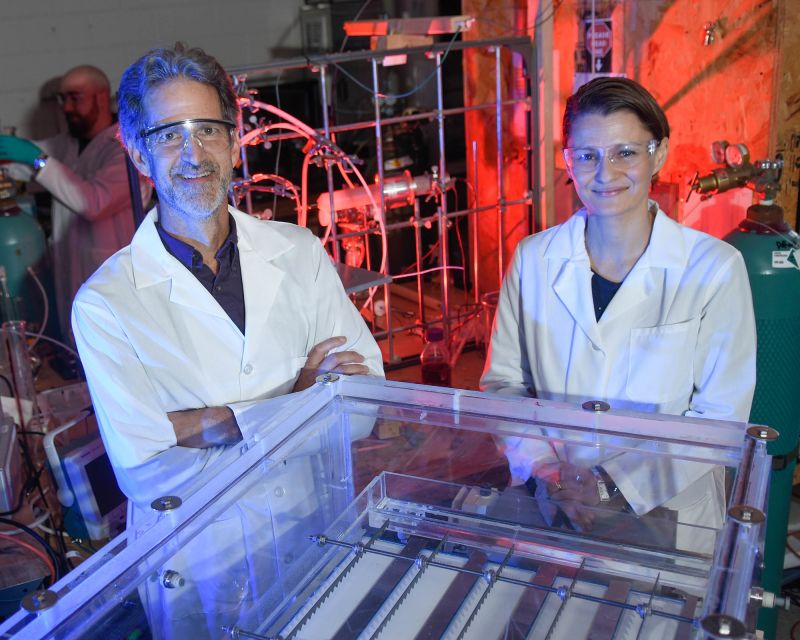U.S. Air Force Funds Innovative Technology to Improve Groundwater Clean Up
Published on by Water Network Research, Official research team of The Water Network in Technology
Clarkson University professors have developed a novel and efficient method of cleaning contaminated water by using an electric discharge plasma.
Cleaning up areas where industrial chemicals have spilled, leaked or been disposed of is a billion-dollar industry in the United States with thousands of sites undergoing or scheduled for remediation. At the same time, conventional groundwater and soil clean up systems are proving to be too costly or of limited effectiveness for some types of chemicals.

Source: Clarkson University
Professors Thomas Holsen and Selma Mededovic Thagard, faculty at Clarkson University’s Wallace H. Coulter School of Engineering, have developed a novel and efficient method of cleaning contaminated water by using an electric discharge plasma.
he promising technology has earned Holsen and Mededovic Thagard, and their co-PI Stephen Richardson, principal engineer at GSI Environmental Inc., a $1-million grant from the United States Air Force (USAF).
The two Clarkson researchers have built a device called an enhanced contact electrical discharge plasma reactor, which contains metal electrodes that transmit electricity through a gaseous (argon) layer. The electricity flow forms a high-energy plasma at the electrode tips.
“The plasma acts like fire. When spread across the water surface, it destroys contaminants that linger at the interface of the gas and water,” said Mededovic Thagard. The reactor uses only electricity to create plasma. It requires no chemical addition and produces no waste.
The contaminants of interest are poly- and perfluoroalkyl substances (PFASs), a group of manmade chemicals used historically for a wide variety of residential, commercial and industrial purposes, including nonstick cookware, stain-resistant fabric and carpet, some food packaging and commercial and military firefighting foam. PFASs are of growing concern because of their persistence in the environment.
Measurements of groundwater at numerous military firefighting foam release sites reveal PFAS levels significantly higher than would be allowed in drinking water based on current health advisory levels. The most common approach for eliminating these contaminants from the water is to use granular activated carbon (GAC) filters. The downside of using this approach is that it only transfers PFAS from one medium (water) to another (GAC). One of the Air Force’s goals is to find a technology that completely destroys PFASs or at least breaks them down to compounds that are less toxic. Clarkson’s plasma reactor can potentially solve these problems.
The argon plasma in the reactor is responsible for creating a wide range of oxidative and reductive species. The reductive species destroy and break PFASs down into less toxic products that either remain in the water, or are released into the atmosphere as harmless gases.
The Clarkson researchers also predict that their plasma technology will reduce cleaning costs by 50 to 80 percent.
Mededovic Thagard and Holsen are also working on modifying the system so that it can eliminate a wider range of contaminates in smaller volumes of water, thereby increasing efficiency and reducing costs even further.
“We are excited to be able to work with the Air Force to test our process at one of their sites,” says Holsen. “With many sites containing PFASs needing remediation, we hope our process can be a game changer in terms of lower treatment costs and better treatment efficiency.”
Clarkson University educates the leaders of the global economy. One in five alumni already leads as an owner, CEO, VP or equivalent senior executive of a company. With its main campus located in Potsdam, New York, and additional graduate program and research facilities in the Capital Region and Beacon, N.Y., Clarkson is a nationally recognized research university with signature areas of academic excellence and research directed toward the world's pressing issues.
Through more than 50 rigorous programs of study in engineering, business, arts, education, sciences and the health professions, the entire learning-living community spans boundaries across disciplines, nations and cultures to build powers of observation, challenge the status quo and connect discovery and innovation with enterprise.
Source: Clarkson University
Media
Taxonomy
- Technology
- Groundwater
- Pollution
- Groundwater Recharge
- Groundwater Assessment
- Groundwater Pollution
- Groundwater Mapping